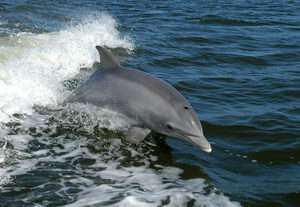June 6, 2006 feature
Marine technology inspired by dolphins' speed

According to Gray’s paradox, dolphins swim faster than they should be able to. Since Gray, scientists have discovered flaws in the details of the paradox, although some explanations of these creatures’ aquatic grace have proven to hold more water than others.
Since the days of Aristotle, humans have looked to dolphins with awe, envy and inspiration because of the marine animal’s speed and strength in the oceans. Swimming at speeds of up to 20 mph, the dolphin seems to defy nature’s laws. In fact, in the 1930s, the scientist James Gray thought that the power needed for the dolphin to swim at such speeds exceeded its available power nearly 10 times over, which is known as Gray’s paradox.
To explain his paradox, Gray theorized that the water against the dolphin’s skin has layers that slide past each other and reduce drag, called “laminar boundary layers.” (It was previously assumed that the water against the skin was made of several mixed layers that increase drag, called “turbulent boundary layers.”) In actuality, no mechanisms have been demonstrated that maintain a completely laminar boundary layer for the dolphin.
“While Gray may have missed the actual mechanism for the high swimming speed of dolphins, his focus on these extraordinary animals and their performance was not without merit,” scientist Frank Fish of West Chester University told PhysOrg.com. Fish, who has researched dolphin drag and propulsion for many years, recently published a review in Bioinspiration and Biomimetics examining the different mechanisms on drag reduction. “[Gray’s] focus on laminar and turbulent flows helped to define a large body of research on animals with consideration to their aquatic adaptations and energetics. Furthermore, because of Gray's work, a whole new mechanism for drag reduction – compliant surfaces – was developed.”
Today it’s common knowledge that Gray’s paradox had a few flawed assumptions: Gray calculated that dolphin musculature resembles that of humans, while in reality dolphin muscles can generate several times the power of human muscles. Also, Gray observed dolphins swimming at short sprints, but neglected to account for the greater power output generated by the type of muscle fiber (fast glycolytic) used for short bursts as opposed to the type of muscle fiber (slow oxidative) used for slow, sustained activity. Finally, Gray did not consider that the dolphin was using a passive drafting technique to swim at high speed.
Despite the flaws in Gray’s paradox, however, the dolphin still possesses superior swimming capabilities compared with technologies from nautical engineering. Throughout the past several decades, scientists have offered a plethora of ideas explaining how the dolphin actually swims as quickly as it does. In his review, Fish examines how these ideas reduce drag, which range from mechanisms for laminar boundary layer conditions (viscous damping and accelerated flow), strategically located skin ridges, skin shedding/secretions, skin heating and others. The two most significant reasons, Fish concludes, are not special mechanisms, but rather the streamlined body shape and behavioral mechanisms.
“Dolphins are among the fastest of marine creatures,” said Fish. “That ability is powered by large muscles that are mechanically linked to an oscillatory pair of flukes, producing thrust with greater efficiency than conventional marine propellers.”
A dolphin’s “fusiform” body shape – with its rounded front, maximum thickness at 34-45% of the body length, and slowly tapering tail – allows water to flow inseparably from the body until the tail region. This delayed separation results in a small wake and reduced drag. Further, the crescent design of the flippers, dorsal fin and tail (“flukes”) of the dolphin reduce drag and can also efficiently generate lift when needed.
Because dolphins belong to the cetacean order, they are mammals that require oxygen. However, wave drag at the surface can reach five times the frictional drag for a dolphin at one-half a body length under water, so the animals use a breathing method called “porpoising.” While maintaining high speeds, a dolphin partakes in a series of rhythmic leaps to the surface, and scientists calculate that it takes less energy to leap at these speeds than to swim an equivalent distance underwater.
A second behavioral mechanism that dolphins employ is gliding, a behavior which allows lung collapse and minimizes buoyancy when descending in deep water, conserving both energy and oxygen. Finally, young dolphins often utilize drafting by swimming below the mid-section of the mother, taking advantage of flow structure and energy savings of up to 60%.
Fish concluded that although Gray’s laminar boundary layer may not have been demonstrated for dolphins, the explanation – along with some of the other proposed ideas – could still have technological applications.
“The need to move more economically on or under the water will necessitate the development of better propulsive systems,” he said. “This will be more important as we further explore the recesses of the ocean, on this planet or others. We currently rely upon rotating propellers to move ships and boats, but these devices have a limited efficient speed range.”
Fish predicted that the development of new hull designs, skin mechanics and propulsive systems may take advantage of nature’s swimming mechanisms.
“Submarine and autonomous underwater vehicles (AUVs) may benefit from copying the body design of dolphins to enhance not just speed but also maneuverability,” said Fish. “The elastic structure of the dolphin skin and its underlying blubber may serve as a model for future wetsuits or competitive swim suits. The arrangement of fibers applied to competition suits will reduce drag from vibrations and folds produced by the swimming motions of human swimmers. Perhaps swimmers in the next Olympics will wear suits based on dolphins to break existing records.”
Citation: Fish, Frank E. “The myth and reality of Gray’s paradox: implication of dolphin drag reduction for technology.” Bioinspiration and Biomimetics. 1 (2006) R17-R25.
By Lisa Zyga, Copyright 2006 PhysOrg.com. All rights reserved. This material may not be published, broadcast, rewritten or redistributed.




















